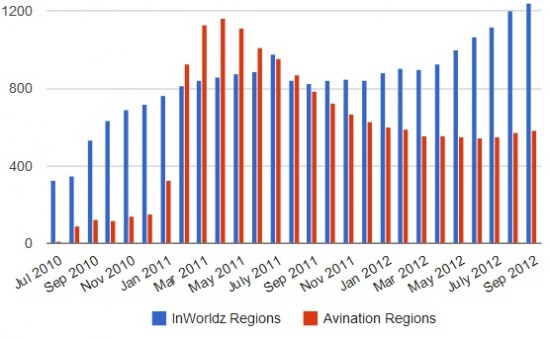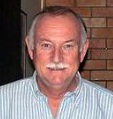The top 40 largest OpenSim grids gained a record-breaking 2,177 regions since mid-August, the single biggest monthly gain in history. The new regions pushed the grids to 23,952 total regions, also a new high.
OSGrid was responsible for almost a quarter of the growth, with 498 new regions, for a new total of 10,323 regions. OSGrid is a non-profit grid that allows people to connect regions hosted at home for free, as well as regions hosted by low-cost third-party hosting providers. OSGrid is the largest grid running on the OpenSim software.

In fact, all the top-40 grids either maintained their land area or gained regions, with the exception of the education-oriented JokaydiaGrid, which lost just three regions.
Kitely was in close second place with 365 new regions, for a new total of 2,493 regions. Kitely is the largest commercial grid running on the OpenSim software, and is unique for its pricing model — it charges by the hour — and in the way the regions run in the cloud and are only booted up when they’re needed.
Kitely’s megaregions
Much of Kitely’s growth could be attributed to its latest new feature — megaregions. Â Customers can now get their regions grouped together into larger landmasses — squares of four, nine, or sixteen regions. The “megaregion” option removes all border crossings, making the new areas look and act like single, large regions, with no border crossing hiccups and easier vehicle scripting.

“Kitely now offers 16-region worlds that can hold up to 100,000 prims and 100 avatars for a price that is lower than what most other grids charge for a single region that can support a lot less prims and avatars,” Kitely CEO Ilan Tochner told Hypergrid Business.
Kitely users also launched an independent discussion forum, Kitetalk.
“As a result of these developments we saw a jump in the number of interesting worlds made public, people have been spending more time inworld and the number of people who’ve upgraded to our Gold Plan has increased significantly,” said Tochner.
The company’s Gold Plan allows for unlimited use of the Kitely grid and 20 regions for US $35 a month. Each additional region is $1 per month.
“People have been taking advantage of our offering to open many such big worlds and the number of regions we now host has grown significantly as a result,” he added.
In other news, Kitely began working on transfer stations, the company announced today., a move which will help the grid turn on hypergrid connectivity when the next, more secure, update of the hypergrid protocol is released. Users will be sent to transfer stations if they attempting to log in or hypergrid teleport to a Kitely region if its offline and doesn’t load up fast enough.
Popularity contest
For company and school grids, popularity is not an issue — the grids are set up for a specific purpose, and if they meet that purpose, then they are successful. The same is true for grids run by niche communities.
But when it comes to social grids, the rule is: the bigger and busier, the better. People looking to make new friends will go to the grids that already have the most users. Merchants looking to sell content will go to the grids with the most potential customers. Event organizers looking for the biggest audience… you get the idea.
With that in mind, here is our listing for the 10 most popular grids this month.
Top ten most popular grids:
- InWorldz: 6,621Â active users
- OSGrid: 3,515Â active users
- Avination: 2,365Â active users
- Island Oasis: 902 active users
- FrancoGrid: 880Â active users
- Metropolis: 401Â active users
- Craft World: 394Â active users
- 3rd Rock Grid: 368Â active users
- Kitely: 242 active users
- German Grid: 239Â active users
With the exception of Island Oasis and Kitely, commercial grids lost active users this month. Avination lost 32 active users, 3rd Rock Grid lost 31, German Grid lost 30.
The big gainer was Island Oasis, a small commercial grid of just 90 regions, which gained 341 active users. In fact, it gained more active users than all other top-40 grids combined.
Kitely was in second place, with 47 new active users.
The total number of active users on the top 40 grids dropped to 17,303 this month, 61 actives less than August’s 17,364 users, mostly due to the fact that ReactionGrid has shut down its OpenSim grid and no longer appears in our stats.
InWorldz — despite gaining 1,794 new registered users — lost 297 active users compared to last month. That still puts it far ahead of other grids, including Avination.  InWorldz and Avination are the top two closed, commercial grids and directly compete for residents. Both make their money primarily from land rentals.
And InWorldz continued to pull away from Avination when it comes to land area.

OpenSim migration accelerating
Second Life lost 312 regions since mid-August, according to data from Grid Survey. Second Life now has a total of 28,902 regions, a decline of 2,238 regions from this time last year, and a drop of 2,983 regions from its peak in June 2010. Second Life no longer reports active user numbers.
Groups that have made the migration are reporting that they can get more land and better service for much less money in OpenSim.
In addition, many OpenSim grids — over 100, at least count — are hypergrid-enabled, allowing users to easily teleport from one grid to another to visit friends, shop, or attend events. The biggest problems — security, lack of content, and lack of users — are also improving steadily.
“OpenSim is a very likable place, and so are the people involved in it,” said Per Eriksson, founder of Australian virtual design firm Troppo Design. The company runs the Troppo Club OpenSim grid. Its latest project is The Lost Castle, a 29-region recreation of the historic 1613 Mori Tadamasa’s Castle from Tsuyama, Japan, which is a setting for machinima-style animated film production.
At first, Eriksson said, he thought that Second Life and OpenSim would grow closer together. However, despite a successful Second Life-to-OpenSim teleport test by IBM and Linden Lab in 2008, the inter-grid teleport project was abandoned.

“I can’t see that happening now,” Eriksson said. He said that he will shut down his last Second Life region before the end of this year. “The hypergrid is really what it’s all about.”
Both of Eriksson’s OpenSim grids are hypergrid-enabled, which means that users can teleport to and from other grids. Today, the hypergrid allows users to make friends, send instant messages, and create landmarks. The next version of the hypergrid protocol is expected to have new security standards, allowing creators to decide whether individual objects can leave their home grids or not.
Jokaydia’s Jo Kay said that she is cutting back on her Second Life holdings, as well. The education-focused Islands of Jokadia community has been reduced from four regions to one region.
“The original Jokaydia sim remains and will continue to be our headquarters inside the walled Linden garden,” she said. Meanwhile, the hypergrid-enabled JokaydiaGrid now has 83 regions.
And Chris Collins, founder and manager of the Center for Simulations & Virtual Environments Research at the University of Cincinnati, recently wrote a much-discussed post calling on Second Life users to expand to other platforms. Collins has also long been active in Second Life, including running last year’s community convention and serving and the director of the education-oriented Chilbo Community, which has also been reducing its Second Life land area.
“Five or six years ago, you could not have found a more enthusiastic and engaged supporter of the Second Life platform than me,” Collins wrote.
Since then, she wrote, it has become clear that Second Life has abandoned its early vision of a metaverse future.
“They are simply not interested in having their virtual world participate in any of this metaverse stuff at all,” she wrote. “Does this mean you have to leave Second Life? No of course not, even I haven’t done that. I still have projects for work in Second Life … and I still have a strong connection to my friends, colleagues, and communities in Second Life. But I have tiered down, way down, and I have begun to invest my time and money largely elsewhere… I think if you care at all about making the metaverse a reality, that’s what you should do, too.”
Collins, also known as “Fleep Tuque†in-world, is the owner and founder of the 16-region hypergrid-enabled FleepGrid.
Transitions
The following 33 grids seemed to be suspended this month: Carohome5, Carpathes-Grid, Cholul, Dawn Grid, Destiny Zero, Fantasy World, Fargis, Free Open Grid, GstarCAD, HewittSim, IceGrid, Kelly & James Fantasy Playground, KorolovGrid, Meridian Grid, My3dLife, NewtonGrid, OpenMoodScience, Pandora, Planet Envee,  Sirius, Southern’s Place, Swondo World, Tanjas World, The Hive, ThunderLife, Verkosis , Winter Heat, World of Eternity, Xscape Grid, Yeah Right, and You3D.
In addition, ReactionGrid’s namesake grid shut down, as ReactionGrid the company refocuses away from OpenSim to development of its propritary Unity-based Jibe virtual world platform.
New grids
This month, we’ve added several new grids to our database, including The Lost Castle, Vaginchen Twig, CSC9N5 Virtual World, Moehlenhoff, PonyLand, SirinHGpole, Virtual Marin, and the Greek-language AVIlife.
If there’s a public grid we’re not tracking, please email us at editor@hypergridbusiness.com. There’s no centralized way to find OpenSim grids, so if you don’t tell us about it, and Google doesn’t alert us, we won’t know about it.
Well, there is one centralized way to find some grids — the New World Studio grid directory. It currently lists 1,032 different worlds, totaling 9,398 regions. There are many duplicates on this list, however, and few worlds were up when we checked.
However, there are also statistics for one popular version of OpenSim, the Diva Distro, a four-region, hypergrid-enabled, pre-configured minigrid.
The Diva Distro has been downloaded 93 times over the past month, possibly because people were waiting for the new update, which was released earlier this month — and updated yesterday. The total number of Diva Distro downloads now stands at 16,379. This does not mean that there are sixteen thousand mini-grids out there, however — someone might download the software but never use it, or download it once and use it to set up many grids. And it doesn’t include the Diva Distros used as part of the New World Studio distribution of OpenSim.
Diva Distro is also part of Sim-on-a-Stick, a version of OpenSim packaged to run on a USB stick. According to Sim-on-a-Stick creator Ener Hax, the USB-friendly OpenSim package has been downloaded 1,020 times over the past month, bringing the total of these downloads to 14,795.
Meanwhile, according to data from The Hypergates, the number of hypergates increased by 53, to a new high of 613. Hypergrid jumps decreased from 2,508 to 2,484 this month. The Hypergates did not report the total number of travelers this month.
This data is very limited, however. For example, not all hypergates are part of The Hypergates network — anyone can create their own hypergate by dropping a script on any object, such as our touch or walk-through single-destination hypergate script. In addition, many people do hypergrid jumps without using any gate at all, simply by typing a hypergrid address into Map-Search, or by using a hypergrid landmark created during a previous jump. There is currently no way of tracking that traffic.
Our own Hyperica directory now tracks 102 grids that are accessible via hypergrid, up from 101 last month. (We’re running behind on adding grids to the directory.) This past month also saw 86 unique visitors to the Hyperica in-world hypergate terminals, up from 82 the previous month.
September Region Counts on the Top 40 Grids
We are now tracking a total of 360 different publicly-accessible grids, 194 of which were active this month, and 156 of which published their statistics. Many school, company or personal grids do not publish their numbers.
The raw data for this month’s report is here. A list of all active grids is here.
- OSGrid: 10,323 regions
- Kitely: 2,493 regions
- ScienceSim: 2,411 regions
- InWorldz: 1,238 regions
- Virtual Worlds Grid: 938 regions
- Metropolis: 834 regions
- The Other Universe: 714 regions
- Avination: 585 regions
- FrancoGrid: 562 regions
- MyOpenGrid: 508 regions
- SpotOn 3D: 288 regions
- Lost Paradise: 268 regions
- 3rd Rock Grid: 211 regions
- GridNirvana: 189 regions
- Moses: 182 regions
- Craft World: 136 regions
- Logicamp: 122 regions
- Virtual Highway: 114 regions
- Gay Nations: 109 regions
- Virtyou: 109 regions
- OpenSim.ru: 104 regions
- Infinite Grid: 101 regions
- 3DWeb: 100 regions
- Neuland: 95 regions
- Speculoos: 94 regions
- AviWereld: 92 regions
- Island Oasis: 90 regions
- SimValley: 90 regions
- eceCloud: 84 regions
- JokaydiaGrid: 83 regions
- German Grid: 82 regions
- PMGrid: 80 regions
- Altera Vita: 77 regions
- Savage Grid: 74 regions
- Dorena’s World: 66 regions
- A Virtual World: 65 regions
- YourSimSpot: 64 regions
- GerGrid: 63 regions
- TUIS Open Grid: 60 regions
- linkinulife: 54 regions
- Analysts predict drop in headset sales this year - March 25, 2025
- OSgrid enters immediate long-term maintenance - March 5, 2025
- OSgrid wiping its database on March 21: You have five weeks to save your stuff - February 15, 2025
